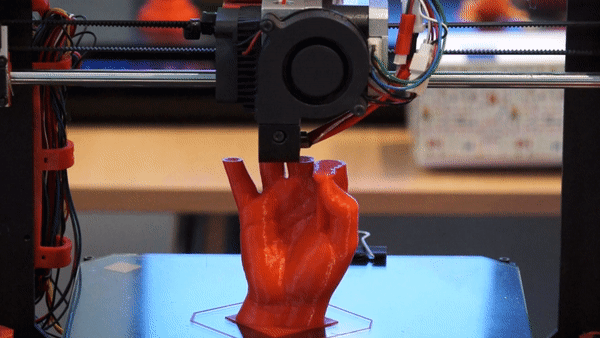Disruptive technologies such as big data analytics, cloud computing, Internet of Things are likely to shape the future of supply chain management. According to industry experts, 3D Printing will also be a game changer with the potential to dramatically change the way supply chains are structured and work. Although 3D printing is still mostly used for prototyping, it is estimated that within a few years about 80% of global printing capacity will be dedicated to manufacturing finished goods according to a recent report. The same report estimates that the 3D printing may become a $400 billion market by 2030, led by the machinery/equipment sector, followed by “textiles/furniture/jewelry/toys, automotive & other transportation, medical devices, mining/metal/other industrial process, chemicals, high tech, and aerospace & defense. Gartner Research also estimates that by 2019, nearly 5.6 million 3D printers will be purchased annually, compared to an estimated 106,000 printers in 2014.
The large scale deployment of 3D printing in several sectors, if the technology advances as expected, is likely to have a dramatic impact on future supply chains. 3D printing has the potential to change how product design, sourcing, planning, manufacturing, stocking, delivering, and return decisions are taken. The good news is that 3D printing will probably help reduce supply chain complexity, while allowing firms to offer more complex and personalized products.
Indeed, a positive impact on supply chains can be expected. For instance, it could facilitate the transition towards a more distributed supply chain structure, with manufacturing happening in smaller mobile facilities (containerized production with 3D printers installed or even home-based production where “prosumers” manufacture their own products) closer to where consumers are. This, in turn, would result in reduced lead times, transportation costs and carbon emissions (environmental benefits). Additionally, sourcing risks would be reduced, as the same products can easily be produced in multiple locations across the globe at the same time. It can also reverse the delocalization trend by making and delivering locally and reshoring some manufacturing activities due to less labor-intensive printing operations, contributing to local economies; move from a make-to-stock (push system) to a make-to-order (pull system) approach due to the ability of 3D printers to produce on-demand; and better serve customer needs via mass customization, manufacturing to customer specifications in smaller scale (as opposed to producing goods of the same type in bulk with traditional manufacturing).
Specifically, inventory management would become much less complicated as the need for production tooling, sub-assemblies, components, fixtures are supposed to disappear with additive manufacturing. Moreover, 3D printing would lead to reduced finished goods inventory levels as well as inventory obsolescence risk because of production in smaller lot sizes, mainly due to additive manufacturing from mostly a few input types (e.g., plastic, metal) without the requirement to substantially change the set-up or obtain the necessary tools, components, fixtures, etc. The impact on spare parts inventory management will be significant in particular. Replenishment of spare parts, which normally is a source of headache for many firms, would no longer be an issue as 3D printing allows manufacturers to produce these parts on site whenever needed.
Market structures are also likely to change drastically with the advance of rapid manufacturing technologies such as 3D printing. Such manufacturing technologies would reduce the cost to establish manufacturing facilities and increase the ability to scale up the deployment, both in terms of geographical expansion or capacity expansion. It is much easier to share licenses and codes (e.g., Computer Aided Design packages) and start printing at different locations concurrently than to establish new manufacturing facilities with traditional manufacturing techniques. Consequently, lower barriers for smaller firms to enter the market competing with larger players will lead to a level playing field and possibly a higher number of potential suppliers. 3D printing also would lead to increased innovation flexibility enabling firms to very quickly experiment with new prototypes/products of complex shapes and structures without the need to invest in expensive machinery, tools, components that are normally needed in traditional manufacturing.
Last, 3D printing has the potential to lessen the damage to environment. Less raw materials would be needed for production and less waste will be generated because of “additive manufacturing” with 3D printing as opposed to “subtractive manufacturing” with traditional production tools, particularly beneficial in automotive and aerospace industries. On top of that, “returns” from customers would be reduced because of better customer service (i.e., personalized products) and easier management of reverse logistics because of close proximity to end consumers.
As good as it sounds in theory and with limited but promising applications in industry, especially given the trends of the consumer demand for highly personalized complex products in smaller volumes, there are certain barriers industry will face before the aforementioned benefits can be materialized at a large scale. In what follows, the potential barriers against a large scale deployment of 3D printing are:
- Higher energy requirements (50 to 100 times more than injection molding on products of the same weight) with 3D printing, which make it costly for large-scale manufacturing and the potential health risk due to melting plastics
- Intellectual Property right issues, as it is easier to copy something produced on a 3D printer. 3D printing will cost $100 billion per year in IP infringement according to a Gartner report,
- It is not possible to produce items of all sizes with the currently available technology, resulting in limited product dimensions,
- 3D printers currently do not enjoy the economies of scale as traditional manufacturing does and the time it takes to print products may be relatively large compared to that of traditional manufacturing.
Although the use of 3D printing in manufacturing is still in its infancy, the potential impact it could have on supply chains seem to be significant. In a recent survey by PWC, 30% of manufacturers believe that 3D printing could restructure the global supply chain. The benefits are especially clear for firms that aim to offer personalized/customized complex products to the consumers at low volumes of production based on observed demand. Firms must carefully analyze the tradeoff between costs of employing 3D printers for manufacturing and the reduced supply chain complexity and associated costs.
Author: Dr. Mustafa Çagri Gürbüz, Professor at ZLC and Research Affiliate at MIT CTL. Read bio
Related links:
-
- Read more Managerial Publications >> https://www.zlc.edu.es/research/managerial-publications/
- ZLC Core Research Areas >> https://www.zlc.edu.es/research/core-research-areas/
- ZLC Research Projects >> https://www.zlc.edu.es/research/projects/
- About ZLC
Zaragoza Logistics Center (ZLC) is a research and educational institute affiliated to the Massachusetts Institute of Technology (MIT) and the University of Zaragoza (UZ). Specialized in logistics and supply chain management, ZLC is the Spanish center of the MIT Global SCALE Network, an international alliance of 6 leading research centers dedicated to the development of supply chain excellence through innovation.
Social Media Links for ZLC: Linkedin; Facebook, Twitter, YouTube
Recommended Reading
The 3D Printing Handbook: Technologies, design and applications
3D Printing 101: The Ultimate Beginners Guide
About the Author- Dr Muddassir Ahmed
Dr MuddassirAhmed is the Founder & CEO of SCMDOJO. He is a global speaker, vlogger and supply chain industry expert with 17 years of experience in the Manufacturing Industry in the UK, Europe, the Middle East and South East Asia in various Supply Chain leadership roles. Dr. Muddassir has received a PhD in Management Science from Lancaster University Management School. Muddassir is a Six Sigma black belt and founded the leading supply chain platform SCMDOJO to enable supply chain professionals and teams to thrive by providing best-in-class knowledge content, tools and access to experts.
You can follow him on LinkedIn, Facebook, Twitter or Instagram










